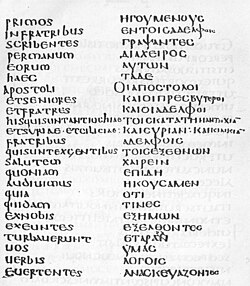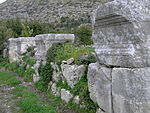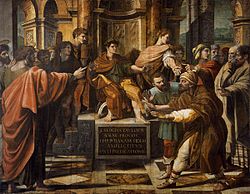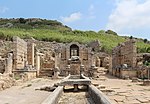Acts 13
| Acts 13 | |
|---|---|
 Acts 15:22–24 in Latin (left column) and Greek (right column) inCodex Laudianus,written about AD 550. | |
| Book | Acts of the Apostles |
| Category | Church history |
| Christian Bible part | New Testament |
| Order in the Christian part | 5 |
Acts 13is the thirteenth chapter of theActs of the Apostlesin theNew Testamentof theChristianBible.It records the first missionary journey ofPaulandBarnabastoCyprusandPisidia.The book containing this chapter isanonymous,but early Christian tradition uniformly affirmed thatLukecomposed this book as well as theGospel of Luke.[1]From this point onwards, except for theCouncil held in Jerusalem(Acts 15), Luke's narrative focusses on Paul, his ministry, and the events of his life.[2]
Text
[edit]The original text was written inKoine Greek.This chapter is divided into52 verses.
Textual witnesses
[edit]Some earlymanuscriptscontaining the text of this chapter are:
- Codex Vaticanus(AD 325–350)
- Codex Sinaiticus(330–360)
- Codex Bezae(~400)
- Codex Alexandrinus(400–440)
- Codex Ephraemi Rescriptus(~450; extant verses 2–52)
- Codex Laudianus(~550)
Old Testament references
[edit]The apostle Paul's "potted resume ofIsrael's history"[3]in this chapter includes a number ofOld Testamentreferences:
- Acts 13:17:Exodus 1:1andExodus 13:14[4]
- Acts 13:18:Exodus 13:16[4]
- Acts 13:20:John 14:1andJudges 3:9[4]
- Acts 13:21:1 Samuel 8:5[4]
- Acts 13:22:Psalm89:20;[5]1 Samuel 13:14[4]
- Acts 13:23:Isaiah 11:1[4]
- Acts 13:33:Psalm2:7[6][4]
- Acts 13:34:Isaiah 55:3[4]
- Acts 13:35:Psalm16:10[6]
- Acts 13:36:Psalms 16:11[4]
- Acts 13:38:1 Kings 2:10[4]
- Acts 13:40–41:Habakkuk 1:5[4]
- Acts 13:47:Isaiah 49:6[4]
New Testament references
[edit]- Acts 13:24:Matthew 3:1[4]
- Acts 13:25:John 1:20[4]
- Acts 13:28:Matthew 27:22[4]
- Acts 13:30:Matthew 28:6[4]
- Acts 13:33:Hebrews 1:5;5:5[6]
- Acts 13:51:Matthew 10:14[4]
Locations
[edit]This chapter mentions the following places (in order of appearance):
- Antioch,Syria
- Seleucia (Greek:σελευκεια), i.e.Seleucia Pieria,the port serving Antioch
- Cyprus:Salamis,Paphos
- Perga,Pamphylia
- Jerusalem
- Antioch,Pisidia
- Iconium,Phrygia
Timeline
[edit]The first missionary journey of Paul and Barnabas took place about AD 47–48.[7]
The church in Antioch (13:1–3)
[edit]
This section opens the account of Paul's first missionary journey (Acts 13:1-14:28) which starts with a deliberate and prayerful step of the church in Antioch, a young congregation established by those who had been scattered frompersecutionin Jerusalem (Acts 11:20–26) and has grown into an active missionary church.[3]Paul's mission was not his own initiative, but was undertaken at the command of the Holy Spirit (verses 2,4), with the framework of prayer and fasting forming aninclusioat the end of this first journey (Acts 14:26).[3]
Verse 1
[edit]- Now in the church that was atAntiochthere were certain prophets and teachers:
- Barnabas,
- Simeon who was called Niger,
- Lucius of Cyrene,
- Manaenwho had been brought up with Herod the tetrarch, and
- Saul.[8]
ThisLucius of Cyreneis thought to be the same person as mentioned inRomans 16:21,or the same asLuke,the writer of theGospel of Lukeand theActs of the Apostles.[9]Heinrich Meyer observes that:
The order of the persons named is, without doubt, such as it stood in the original document: hence Barnabas and Saul areseparated;indeed, Barnabas is placed first (the arrangement appears to have been made according to seniority) and Saul last; it was only by his missionary labours now commencing that the latter acquired in point of fact his superiority.[10]
Verse 2
[edit]- As they ministered to the Lord and fasted, the Holy Spirit said, "Now separate to MeBarnabasandSaulfor the work to which I have called them. "[11]
Verse 3
[edit]- Accordingly, after fasting and prayer, they placed their hands on them and dismissed them.[12]
This ritual oflaying on handsrelates to the two apostles being commissioned for a specific task: it is not anordination.[3]
Journey from Antioch to Cyprus (13:4–5)
[edit]The first main destination of the missionary journey is the island ofCyprus,Barnabas' home area (Acts 4:36). There were already believers who scattered due to the persecution in Jerusalem (Acts 11:19), but Barnabas and Saul came on a mission ('sent out by the Holy Spirit', verse 4) to visit formal meeting-places of Jewish communities they pass through (verse 5) to preach the gospel.[3]
Verse 4
[edit]
- So, being sent out by the Holy Spirit, they went down toSeleucia,and from there they sailed toCyprus.[13]
The governor and the guru (13:6–12)
[edit]
The account of Saul/Paul displaying the supernatural power of the Holy Spirit (verse 9) that led a proconsul into faith (verse 12) parallelsSimon Peter's encounters withSimon Magus(Acts 8:14–24), and withAnanias and Sapphira(Acts 5:1–11). Paul sharply denounced Elymas using a prophetic language (verses 10–11) that resulted in the latter's blindness using words echoing Paul's own experience inActs 9:8–9.[3]
Verse 6
[edit]- Now when they had gone through the island to Paphos, they found a certain sorcerer, a false prophet, a Jew whose name was Bar-Jesus,[14]
It is noted from his failure to recognize the truth of gospel (verse 8) that Elymas is a 'false prophet', using the termmagus(verses 6, 8), which is always in negative sense in the book of Acts (Acts 8:5—13).[3]
Verse 7
[edit]- who was with the proconsul,Sergius Paulus,an intelligent man. This man called for Barnabas and Saul and sought to hear the word of God.[15]
The correct Greek title (anthupatos, proconsul) is used for a governor of a senatorial province. A 'Sergius Paulus' is mentioned in a Roman inscription as a holder of an office in Rome under Claudius (at about the same period)[3]and his family also seems to have a tie toPisidia.[16]
Verse 9
[edit]- However, Saul (who is the same as Paul), full of the Holy Spirit, fixed his eyes on him[17]
The change of name from Saul (a Hebrew name) to Paul (Latin name; verse 9) is appropriate as he moved deeper into "Gentile territory", and very common for diaspora Jews to have Greek or Latin names alongside their Hebrew names.[3]
Verse 12
[edit]- Then the proconsul believed, when he saw what had been done, being astonished at the teaching of the Lord.[18]
LukepresentsSergius Paulusas the first Gentile ruler to believe the gospel. UnlikeCornelius(Acts 10:2), there is no evidence that Sergius attended the temple or was a God-fearer. This pagan government official was amazed at the power of God and believed the truth.[19]
Journey from Cyprus to Pisidia (13:13-52)
[edit]It is customary for Paul to start his mission by visiting the local synagogue (verse 14). Paul's sermon in a synagogue of Antioch in Pisidia (13:16—41) serves as the centerpiece of a long and tightly constructed travel-and-mission account, moving into new places (13:13-14, 51; 14:6-7), then successively going back retracing each stage of the journey (14:21, 24–26).[3]All the sites visited by Paul on this journey eventually fall within the territory of the Roman province of Galatia in the first century,[20]so it could be assumed that 'these are the churches Paul addresses in theEpistle to the Galatians'.[3]
Verse 13
[edit]
- Now when Paul and his party set sail fromPaphos,they came toPergainPamphylia;and John, departing from them, returned toJerusalem.[21]
ThisJohn,also mentioned in verse 5, wasJohn Mark,the nephew ofBarnabas(Acts 12:25). Whatever the trouble was between Paul and John Mark, it was enough for Paul not to want John Mark to accompany him on a later journey, which caused a rift between Paul and Barnabas (Acts 15:36–39). John Mark would prove faithful later in Paul's ministry (see2 Timothy 4:11).[19]

Verse 33
[edit]- God has fulfilled this for us their children, in that He has raised up Jesus. As it is also written in the second Psalm:
- ‘You are My Son,
- Today I have begotten You.’[22]
CitingPsalm 2:7,which is also quoted and used for exposition inHebrews 1:5;5:5.[6]
Verse 34
[edit]- And as concerning that he raised him up from the dead,
- now no more to return to corruption,
- he said on this wise,
- I will give you the sure mercies of David.[23]
CitingIsaiah 55:3
See also
[edit]References
[edit]- ^Holman Illustrated Bible Handbook. Holman Bible Publishers, Nashville, Tennessee. 2012.
- ^Alford, H.,Greek Testament Critical Exegetical Commentary - Alfordon Acts 13, accessed 7 May 2024
- ^abcdefghijkAlexander 2007,p. 1044.
- ^abcdefghijklmnopq"Biblical concordances of Acts 13 in the 1611 King James Version".
- ^Kirkpatrick 1901,p. 839.
- ^abcdKirkpatrick 1901,p. 838.
- ^John Arthur Thomas Robinson (1919–1983). "Redating the New Testament". Westminster Press, 1976. 369 pages.ISBN978-1-57910-527-3
- ^Acts 13:1:NKJV
- ^Isaac Asimov.Asimov's Guide to the Bible.The New Testament. New York: Doubleday. 1969.
- ^Meyer, H. A. W., (1880)Meyer's NT Commentaryon Acts 13, translated from the German sixth edition, accessed 7 May 2024
- ^Acts 13:2:NKJV
- ^Open English Bible,Acts 13:3
- ^Acts 13:4NKJV
- ^Acts 13:6NKJV
- ^Acts 13:7NKJV
- ^Nobbs, A. (1994) 'Cyprus', in Gill and Gempf (1994), p. 289;apudAlexander 2007, p. 1044.
- ^Acts 13:9OEB
- ^Acts 13:12NKJV
- ^abThe Nelson Study Bible. Thomas Nelson, Inc. 1997
- ^Hansen 1994, p. 382;apudAlexander 2007, p. 1044.
- ^Acts 13:13NKJV
- ^Acts 13:33NKJV
- ^Acts 13:34KJV
Sources
[edit]- Alexander, Loveday (2007). "62. Acts". In Barton, John; Muddiman, John (eds.).The Oxford Bible Commentary(first (paperback) ed.). Oxford University Press. pp. 1028–1061.ISBN978-0199277186.RetrievedFebruary 6,2019.
- Coogan, Michael David (2007). Coogan, Michael David; Brettler, Marc Zvi; Newsom, Carol Ann; Perkins, Pheme (eds.).The New Oxford Annotated Bible with the Apocryphal/Deuterocanonical Books: New Revised Standard Version, Issue 48(Augmented 3rd ed.). Oxford University Press.ISBN9780195288810.
- Kirkpatrick, A. F.(1901).The Book of Psalms: with Introduction and Notes.The Cambridge Bible for Schools and Colleges. Vol. Book IV and V: Psalms XC-CL. Cambridge: At the University Press.RetrievedFebruary 28,2019.
External links
[edit]- Acts 13King James Bible - Wikisource
- English Translation with Parallel Latin Vulgate
- Online Bibleat GospelHall.org(ESV, KJV, Darby, American Standard Version, Bible in Basic English)
- Multiple bible versions atBible Gateway(NKJV, NIV, NRSV etc.)
- Acts 13 OEB

